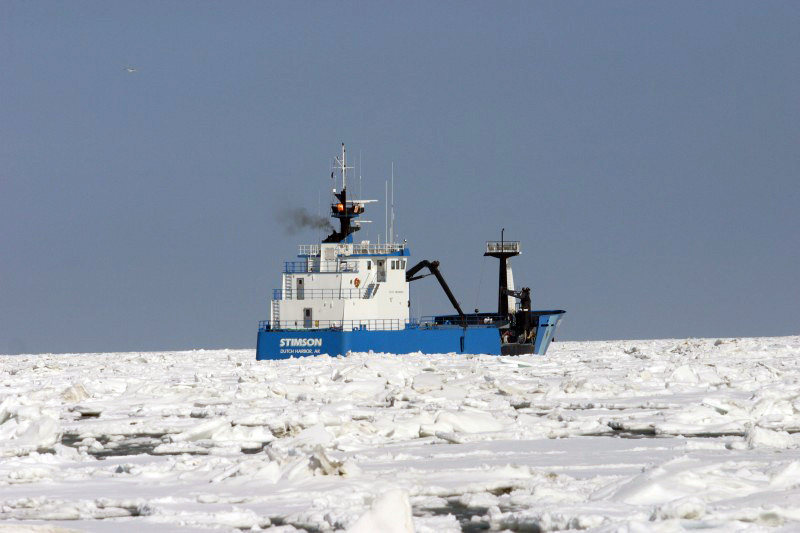Vessel Section
From Ketchikan, Prince William Sound, Kodiak Island,
Alaska Peninsula, Bristol Bay, to the Bering Sea.
The Stimson on-patrol in Bristol Bay.
Alaska is twice the size of Texas, and one-fifth the size of the entire contiguous United States, possessing more than 33,904 miles of coastline. Off-shore of Alaska's coastline are some of the richest fishing grounds in the world. The Division of Alaska Wildlife Troopers is responsible for protecting this valuable resource from the shore to three miles outwards. The organization is also responsible for the preservation of the migratory fish resource, such as salmon, up to 200 miles off-shore of Alaska.
The Bering Sea alone encompasses 886,000 square miles of fishing grounds. The Department of Public Safety's effort in patrol and enforcement of these waters is entrusted to the Alaska Wildlife Troopers. Assigned to the Vessel Section, in conjunction with posts from Ketchikan to Kotzebue, are 17 vessels that range in size from 25 to 156 feet. Numerous other smaller skiffs augment patrol and boarding operations, independently or in support of the Vessel Section.

During Bristol Bay's red salmon six-week fishery alone, there are over 1,900 fishing vessels and 1,000 net sites registered to participate in the harvesting of Alaska's salmon. These types of fisheries not only produce a tremendous amount of enforcement responsibilities for the Vessel Section, but also result in numerous search and rescues for unfortunate mariners.
The patrol vessels are manned by commissioned state troopers from the Division of Alaska Wildlife Troopers. The Vessel Section's larger vessels are manned by U.S.C.G. licensed Masters and First Mates. The patrol vessels Stimson, Enforcer, and Cama'i are additionally manned by Boat Patrol Officers and Vessel Technicians. For the crews of these vital patrol vessels, family life comes in small doses. Patrols often last 30 to 45 days and account for as many as 120 days a year away from home.
Patrols just to arrive on the fishing grounds, such as the Bering Sea, can take four days of navigating due to distances travelled and some of the most challenging weather conditions in the world. Storms with gale and hurricane-force winds 50 to 80 miles per hour, and seas in excess of 30 feet, are not uncommon. There are few hiding places in the Bering Sea and Bristol Bay which, subsequently, leaves the patrol vessels to ride out the storms in the unprotected waters.
For more information on the Alaska Wildlife Trooper vessels, please see below.

- The P/V Stimson is the largest ship in the fleet, at 156 feet in length.
- It is primarily responsible for Bering Sea crab, sable fish, ground fish, and the salmon along the Aleutian Chain, False Pass, and South Peninsula to Bristol Bay.
- Its crew provides enforcement and remote field presence in commercial crab, IFQ fisheries, sable fish, salmon, ground fish, and herring fisheries.
- It also serves as a critical search and rescue platform in the Bering Sea and Aleutian Chain.
- The P/V Cama'i stands at 69' in length.
- It is primarily responsible for salmon patrols from the Cook Inlet to Bristol Bay, including Chignik, Kodiak, False Pass, and the South Peninsula.
- It servces as a critical search and rescue platform.
- Its crew is responsible for providing enforcement and remote field presence in commercial crab, IFQ fisheries, sable fish, salmon, ground fish, herring, and fall/winter game patrols in and around Kodiak, Togiak, Security Cove, Cook Inlet, and Bristol Bay.